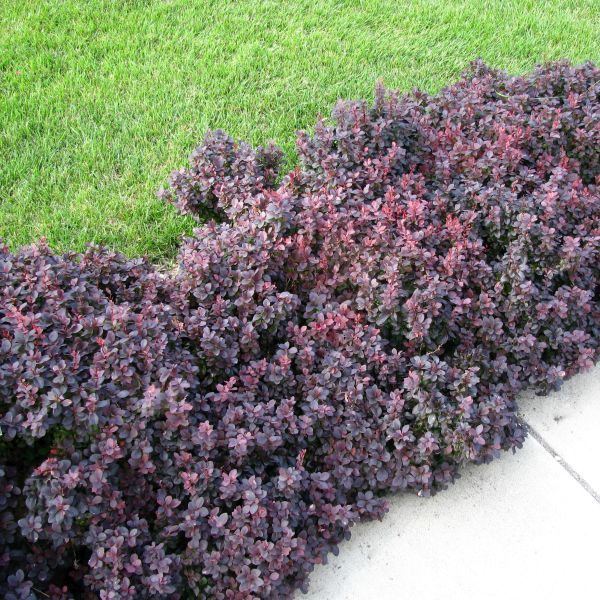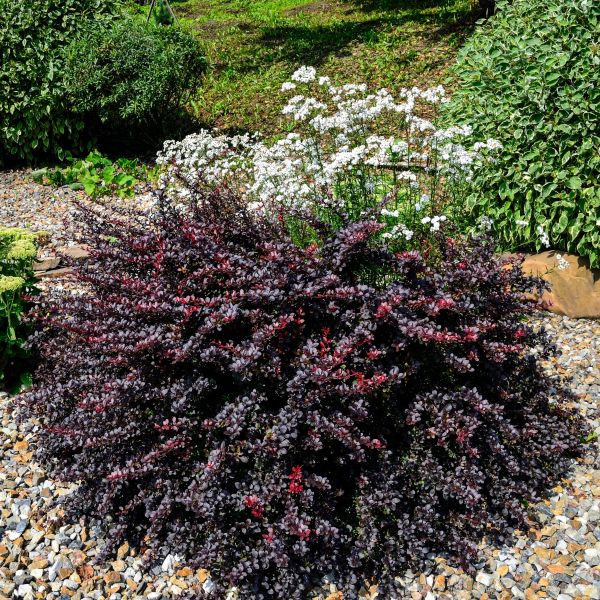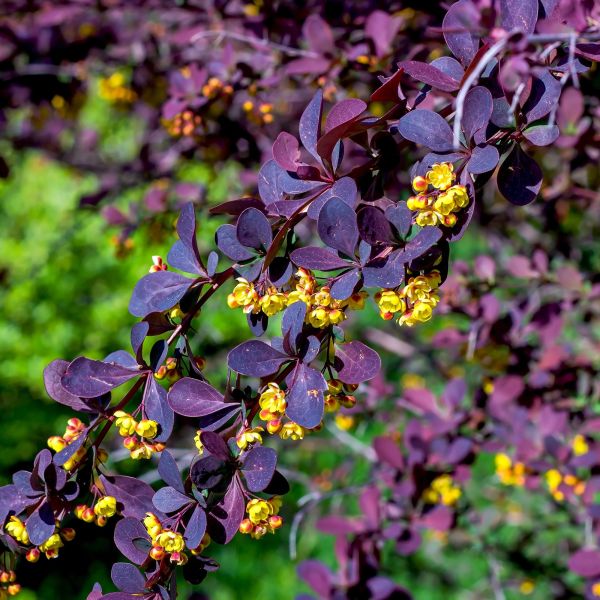


Concorde Barberry
Berberis thunbergii 'Concorde'
82 reviews
Concorde Barberry
Berberis thunbergii 'Concorde'
82 reviews
2.5 Gallon
We are sorry, product is currently out of stock due to seasonal availability. Please check the "Related plants available in your area" section below
Not just beautiful - intentionally selected by ShrubHub's 3D landscape design team to fit real-world spaces and maximize yard potential.
Why Concorde Barberry?
Concorde Barberry is a compact and dense shrub with a stunning burgundy foliage that transforms into a brilliant shade of red in the fall. It grows up to 2-3 feet tall and is resilient, drought-tolerant, and adaptable to most soil types. It is an ideal choice for hedges, mass planting, borders, and accent features in residential landscapes. Concorde Barberry needs minimal maintenance and pest and disease-resistant, making it a perfect low-maintenance addition to any garden.
Sunlight
The Concorde Barberry thrives best in full sunlight or partial shade conditions.
Watering
Concorde Barberry requires moderate watering. It is important to water it consistently during the growing season, allowing the top inch of soil to dry out before watering again. Proper drainage is essential to prevent overwatering and root rot.
Fertilizing
Concorde Barberry typically requires a balanced fertilizer with a ratio of nitrogen, phosphorus, and potassium (NPK) around 10-10-10. However, it is always best to refer to specific instructions or consult with a local gardening expert for accurate fertili
Barberry Concorde, also known by Concorde Japanese Barberry or its scientific name, Berberis thunbergii ‘Concorde’ is a tiny shrub from the Japanese Barberry family. It's known for its distinct, dense deep maroon-purple foliage, small yellow flowers, and bright red berries. Beautiful and petite, Barbery Concorde can be a great small hedge border.
With a max length of two feet, Barberry Concorde shrubs are also slow growers and make for excellent container plants. They are deer resistant, as well as drought tolerant, and less susceptible to the most common diseases.
Barberry Concorde is also a pretty low-maintenance shrub. They are hardy to USDA growing zone range 4-8. It grants you more colorful and dense deep purple foliage when planted in the full sun, but tolerates partial shade, which can also strengthen it.
As for soil conditions, as long as there is even soil moisture (though still well-drained), the shrub is adaptable to different soil types. You'll need to water deeply and regularly for the first growing season. Otherwise, this wonderful shrub won't ask more of you.
The yellow flowers against a distinctly dramatic purple foliage make this shrub stand out among other plants. It's wonderful for rock gardens, foundation plantings, mass planting, and container planting especially in smaller spaces.
Order yours from Shrubhub today and rest assured that your shrub will have received the utmost care from day one and will arrive to you in the healthiest shape possible.
Plant Information:
| Botanical Name: | Berberis thunbergii 'Concorde' |
| USDA Zones: | 4 - 8 |
| Water: | Moderate to Low |
| Exposure: | Full Sun |
| Soil Needs: | Well-Drained |
| Mature Height: | 2 - 3 feet |
| Mature Spread: | 2 - 3 feet |






Pollination Info
Pollination Info for Concorde Barberry
Concorde Barberry (Berberis thunbergii 'Concorde') is a self-fertile shrub, which means that it does not require pollen from another plant to bear fruit. However, the plant can still benefit from cross-pollination from other Barberry plants in the vicinity.
The Concorde Barberry blooms in late spring with small, yellow flowers that are pollinated by bees and other insects attracted to their nectar. The plant produces small, red, and edible berries that attract birds in the fall.
If you want to encourage cross-pollination, consider planting other Barberry cultivars close to the Concorde to provide a variety of pollen sources for bees and other pollinators. You can also attract pollinators to the area by planting other native flowering plants and creating a habitat that supports their survival.
FAQ
Concorde Barberry (Berberis thunbergii 'Concorde') FAQ
What are the characteristics of Concorde Barberry?
Concorde Barberry is a deciduous shrub that grows up to 4 feet tall and wide. It has dark purple foliage that turns bright red in the fall. In the spring, it produces yellow flowers that turn into red berries in the summer.
Where is the best place to plant Concorde Barberry?
Concorde Barberry prefers full sun to partial shade and well-drained soil. It can tolerate a variety of soil types, including clay and sandy soil.
How do I care for Concorde Barberry?
Concorde Barberry requires minimal care. It only needs occasional watering during dry spells and pruning to remove dead or damaged branches. It can also be pruned to maintain its shape and size.
Is Concorde Barberry deer-resistant?
Yes, Concorde Barberry is deer-resistant. Its thorny branches make it unappealing to deer and other animals.
Can Concorde Barberry be used for landscaping?
Yes, Concorde Barberry is a popular choice for landscaping due to its attractive foliage and low maintenance. It can be used as a hedge, border, or accent plant.
Can Concorde Barberry be grown in containers?
Yes, Concorde Barberry can be grown in containers as long as they are large enough to accommodate its root system. It is important to ensure the soil stays moist and the plant is protected from frost in the winter.
Is Concorde Barberry invasive?
No, Concorde Barberry is not considered invasive. However, it can self-seed and spread if not properly maintained.
Planting & Care
Planting & Care for Concorde Barberry (Berberis thunbergii 'Concorde')
Planting
- Choose a location that receives full to partial sun.
- Ensure the soil is well-draining and rich in organic matter.
- Dig a hole twice as wide and the same depth as the root ball.
- Loosen the roots and place the plant in the hole.
- Backfill the hole with soil, firming it down as you go.
- Water thoroughly.
- Apply a layer of mulch to help retain moisture and control weeds.
Care
- Water regularly, especially during dry spells.
- Fertilize in early spring with a balanced, slow-release fertilizer.
- Prune in late winter or early spring to maintain its shape or remove any damaged or dead branches.
- Watch for pests such as aphids or scale insects and treat as needed.
- Monitor for signs of disease such as leaf spot or powdery mildew and take action if necessary.
Check Out These Verified Customer Reviews:
Customer Reviews
4.7 out of 5 based on 82 reviews
Thank you! Your review has been submitted.
Great addition to my garden.
Beautiful vibrant coloring.
Couldn't be happier with my purchase, will definitely buy again!
Item has been added to your cart.


